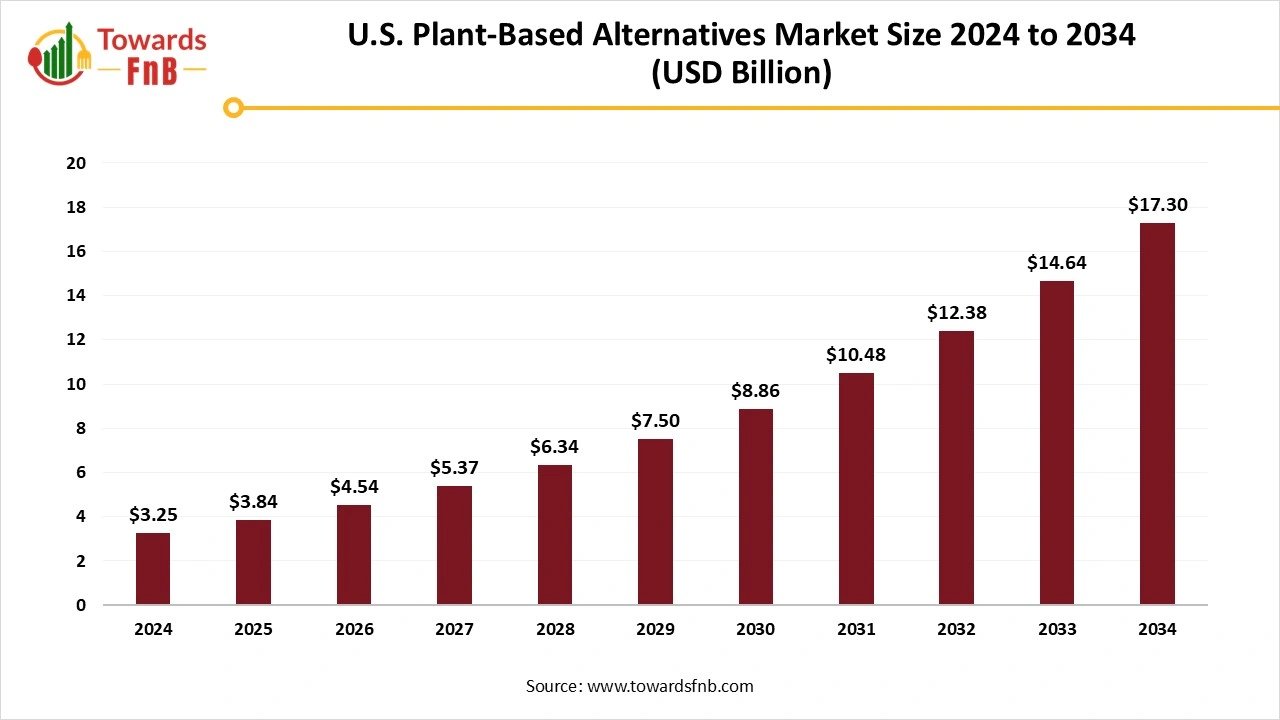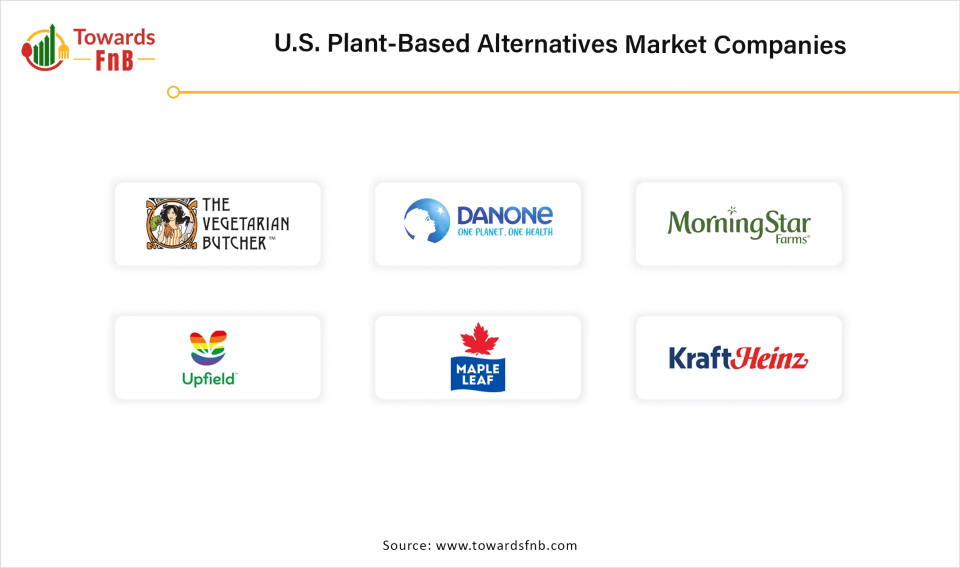December 2025
The U.S. plant-based alternatives market size reached at USD 3.25 billion in 2024 and is anticipated to increase from USD 3.84 billion in 2025 to an estimated USD 17.30 billion by 2034, witnessing a CAGR of 18.2% during the forecast period from 2025 to 2034. The wide expansion of plant-based food processing and the production of fermented, cultivated, or cell-based food products fostered innovations across the globe.

| Study Coverage | Details |
| Growth Rate from 2025 to 2034 | CAGR of 18.2% |
| Market Size in 2025 | USD 3.84 Billion |
| Market Size in 2026 | USD 4.54 Billion |
| Market Size by 2034 | USD 17.30 Billion |
| Base Year | 2024 |
| Forecast Period | 2025 to 2034 |
The U.S. plant-based alternatives market includes food and beverage products that are made entirely or primarily from plant-derived ingredients and serve as substitutes for traditional animal-based products. These alternatives aim to replicate the taste, texture, and nutritional value of meat, dairy, and other animal-derived items while supporting sustainability, health, and ethical consumption. The market spans categories like plant-based meat, dairy, seafood, eggs, and ready meals, and is fueled by rising demand from vegans, flexitarians, and environmentally conscious consumers.
The collaborations with food and tech companies, farmer-tech collaborations, and ingredient supply provide favorable opportunities for innovation. The partnerships with food tech companies, research, and innovations create innovation hubs and support research initiatives. The optimization of value chains allows value-added products to enter into the market through technological integration.
The Asian Pacific countries like India face issues of food insecurity. The environmental concerns are associated with the production of animal-based food products such as dairy, meat, and eggs. There is a great demand for animal meat which results in land conversion for grazing and feed crops. This requires a lot of water and resources, which negatively impacts ecosystems and local communities.
How does the U.S. Support the Alternative Protein Industry?
The USDA makes efforts to invest $3.1 billion in 141 selected projects. There are exports of cultivated meat by the leading companies in the U.S. based on the regulatory requirements from the U.S. FDA and the USDA. Plant-based foods can transform a sustainable food system. The government, citizens, and industries provide recommendations on the sustainable use of plant-based foods. The U.S. FDA provided guidance for industries for best practices in the naming and labeling of plant-based alternatives to seafood, eggs, meat, poultry, and dairy products.
How Plant-based Meat Segment Dominated the Plant-based Alternatives Market in 2024?
The plant-based meat segment dominated the plant-based alternatives market in 2024. The growing awareness regarding nutrition, health, and well-being among global consumers drives the growth of plant-based meat solutions. The use of different ingredients such as potato starch, pea protein, coconut oil, lentils, beans, tofu, soy, wheat gluten, nuts, seeds, and vegetables enhance the quality of plant-based meat products. A less red meat can potentially reduce the risk of heart disease while nutrients are present in the form of fat, saturated fat, protein, carbohydrates, sugars, and dietary fiber. The increased focus of consumers on avoiding added sugars, artificial ingredients, and high calories offers them these products having characteristic features. The increasing intake of plant-based meat in the U.S. is driven by ethical, environmental, and health reasons.
The plant-based seafood and cheese segment is expected to grow at the fastest CAGR in the plant-based alternatives market during the forecast period. Research studies suggest that plant-based seafood provides similar nutritional benefits as fish without causing environmental costs. The functional plant-based seafood and cheese present good solutions to address nutritional deficiencies.
What made Soy & Pea Protein the Dominant Segment in the Plant-based Alternatives Market in 2024?
The soy and pea protein segment will dominate the market in 2024. Pea protein is a rich source of amino acids like arginine and lysine and branch chain amino acids like leucine, isoleucine, and valine. Pea protein supports heart health, is low-carb and high in protein and is a rich source of iron. A soy protein powder and pea protein powder both provide micronutrients, protein content, isoflavones, digestibility, and taste. The soy protein isolates are found in protein-based supplements, dairy products, condiments, certain meat substitutes, and bread products. Soy protein concentrates are found in baked goods, cereals, beer, meat substitute products, and infant milk formula.
The Mycoprotein & fungi-based segment is expected to grow at the fastest CAGR in the plant-based alternatives market during the predicted timeframe.
There are several health benefits of mycoprotein consumption which include antioxidant activity, improved lipid profiling, good muscle strength, reduced energy intake, reduced cardiovascular diseases, and reduced blood glucose levels. The presence of various pigments in fungi such as anthraquinone, flavins, melanins, ankaflavins, naphthoquinone, and quinones offer potential food and medicinal properties.
How did the Flexitarians Segment Dominate the Plant-based Alternatives Market in 2024?
The flexitarians segment dominated the plant-based alternatives market in 2024. The flexitarian diet focuses on eating plenty of vegetables, fruits, legumes, and whole grains. It also recommends consuming natural foods, whole foods, and limiting added sugar and sweets. A flexitarian diet helps in diabetes management, promotes weight loss, prevents cancer, improves heart health, and boosts skin health. The increased preference to limit processed meats, refined carbs, added sugar, sweets, and fast food raises the importance of the flexitarian diet. The emphasis on plant-based food and limiting animal products helps to achieve a nutritional balance and adopt sustainable eating habits.
The lactose-intolerant & allergy groups segment is expected to grow at the fastest CAGR in the market during the forecast period. The plant-based alternatives benefit people with lactose intolerance and allergies by assisting them in gastrointestinal digestion and dietary management. Dairy products are important sources of calcium, vitamin D, and vitamin B12, which are beneficial for lactose-intolerant people.
How Supermarkets & Hypermarkets Segment Dominated the Plant-based Alternatives Market in 2024?
The supermarkets & hypermarkets segment dominated the plant-based alternatives market in 2024. The supermarket businesses in India and across the globe offer several benefits, such as self-service, properly displayed goods, no bargaining policy, etc. The supermarkets offer the ease of dealing with one large customer instead of smaller independent customers. Businesses can experience increased sales with access to a large customer base. Some of the supermarkets and retailers conduct business improvement schemes to help their suppliers by improving process efficiency and expanding their operations. Both supermarkets and hypermarkets can achieve increased sales through product design and packaging design.
The online & foodservice segment is expected to grow at the fastest CAGR in the market during the predicted timeframe. The online food services or online food ordering systems provide ease and convenience for customers to place their orders through websites or mobile applications. The online systems can streamline food ordering processes and other operations within the establishment.
Danone SA
Nestle and SOCIAL

By Product Type
By Protein Source
By Consumer Group
By Distribution Channel
December 2025
November 2025
October 2025
December 2025